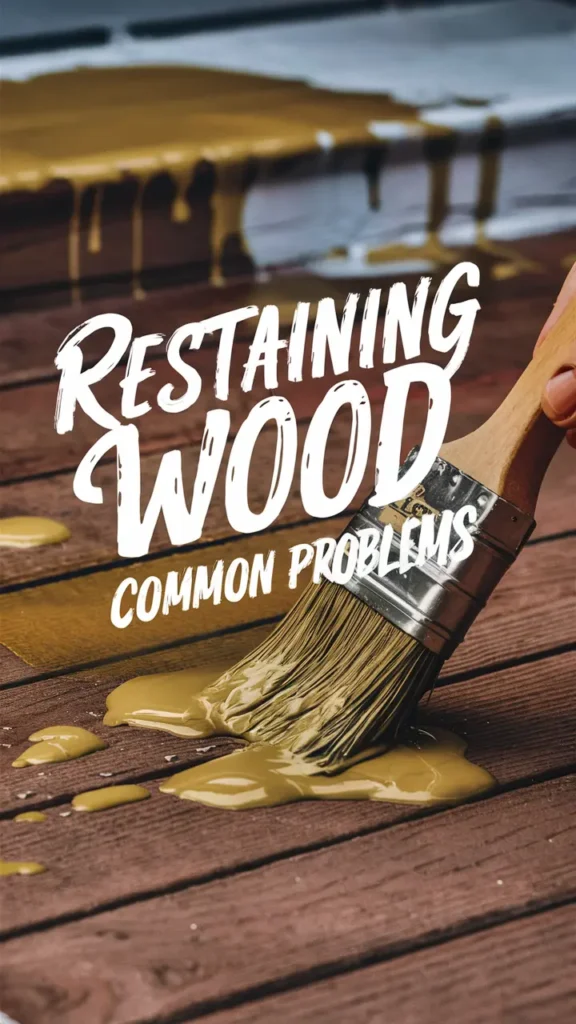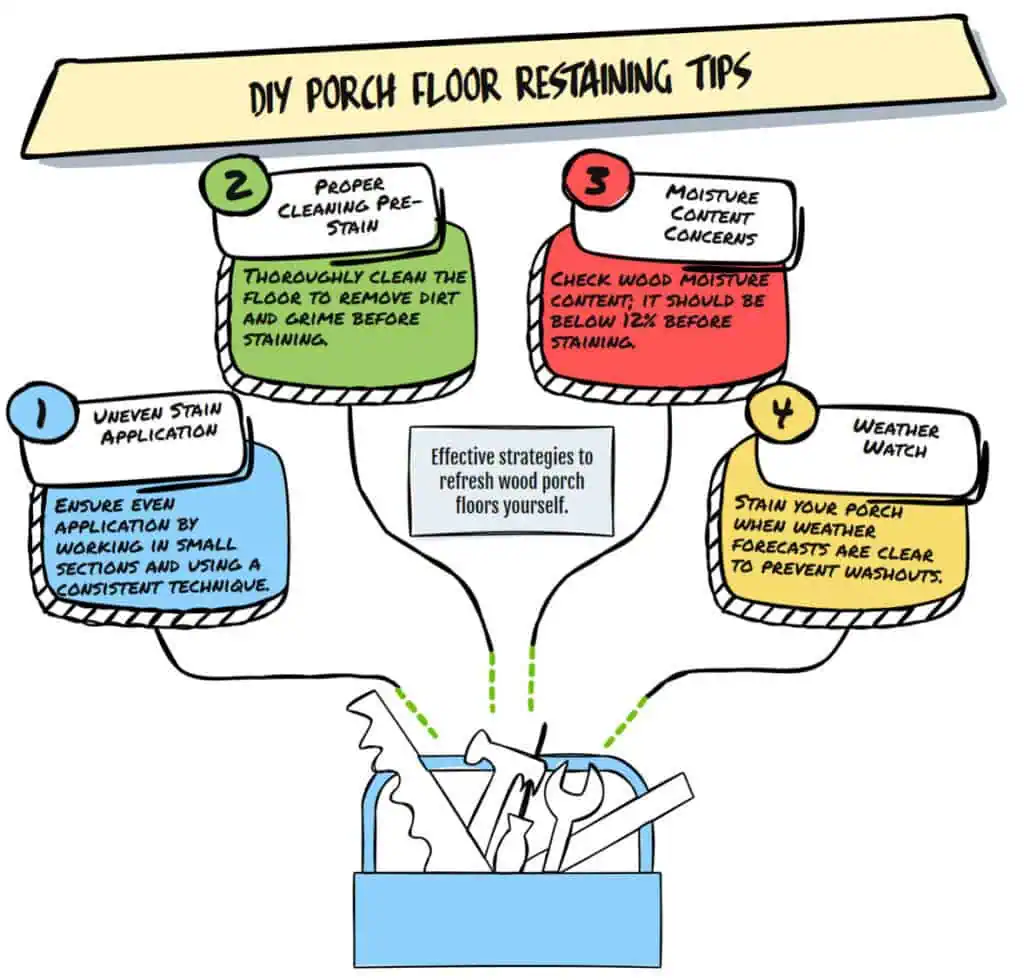Looking back, my first try at refinishing my porch was a disaster. Instead of a beautiful Moonlit Mahogany, my deck became a sticky mess. It was like a scene from a comedy show, with my hands covered in glue and the wood all streaky.
But, I’ve gotten much better since those days. I learned the importance of using the right application techniques and tools for the job. Using a reliable brush made all the difference. Now, I can stain my porch smoothly without any sticky drama.
If you want to avoid the sticky mess I faced, stay tuned. We’ll explore how to apply stain the right way using proper application techniques. This time, we’ll do it without the stickiness.

The #1 Most Important Lesson I Have Learned
Use a quality, thick 4-6″ stain brush. Do not cheap out on the brush. I have two that meet my standards and I would not recommend you buy any other brush.
Wooster or Cabot… PERIOD
Key Takeaways
- First attempts at staining can be messy—preparation and the right tools are key.
- Learn from past experiences to avoid sticky outcomes.
- A great brush is an invaluable tool for even application.
- Successful porch refinishing demands patience and proper stain application techniques.
- Invest in quality wood stains like Cabot Gold for a durable finish.
Preparing Your Tools and Work Area
Before you start, make sure you have your stain brushes, rollers, and sprayers ready. It’s important not to mess up your work because you aren’t organized. Right?
Getting a leak-proof dropcloth is step one. It keeps the place where you’re working clean. Think of it as preparing a spotless canvas, not a messy art project. Your floors will be grateful for it.
Being prepared is key. Here’s what you need:
- Stain Brushes: Use something like the Cabot Stains 4″ Wood Stain Brush for precision and durability.
- Rollers: They’re best for big, flat areas and ensure smooth coverage.
- Sprayers: Ideal for fast work and covering large areas with ease.
When setting up your prep space for staining, keep everything close by. This way, you won’t have to stop and look for tools while working. Having everything set, including a leak-proof dropcloth, means you’re ready for a clean job.
With your stain brushes, rollers, and sprayers at the ready and your dropcloth laid out, you avoid making a mess.

Sanding and Cleaning the Surface
When it comes to sanding wood, being prepared is everything. I’m on a budget, so I use what I’ve got, like my trusty BLACK+DECKER Detail Sander. It zooms at 16,000 orbits per minute (OPM). Plus, it has a comfy 3-position grip for that smooth wood surface we aim for.
After a focused sanding session, cleaning the wood is the next big step. You can’t skip it unless you want a messy finish. A good trick is to use a tack cloth. It lifts away all the dust and bits the sander leaves.
For a really clean surface, I suggest the Painters Tack Cloth. Also, consider the DEFY Wood Cleaner 2LB from Amazon. It’s popular even though it doesn’t list specific cleaning results.
Thorough cleaning isn’t just about effort—it’s key for a top-notch finish. With the wood all sanded and cleaned, it’s ready for a transformation!
Applying the First Coat of Stain
When staining wood, getting the first coat of stain right matters a lot. Forget the brushes to avoid ‘brushstroke city.’ Use a soft cloth wiper instead. It helps apply the stain evenly and keeps the wood happy.
Mastering even coats is the key to a perfect first layer. Pretend you’re Michelangelo, but your canvas is wood. Move slowly for the best results.
Your wood will thank you for being careful to avoid pooling or missed spots. It’s like spreading butter on toast. You aim for an even spread. That way, every swipe with the soft cloth wiper is effective.
For detailed work, consider Pro Grade Paint Brushes. Plus, use FrogTape Multi-Surface Painter’s Tape with PAINTBLOCK for crisp edges.
Mastering Application Techniques
Exploring gel stain introduces new ways to apply it. You might like using a stain pad or a foam brush. Mastering these methods can really change your projects. Before starting, it’s important to wear the right gear. Consider the DEWALT DPG84 Insulator Safety Goggle. They have a 4.3-star rating from nearly 2,000 people. Priced at $14.99, they’re a wise buy. You’ll find them at #51 in the Safety Goggles & Glasses category on Amazon, ideal for eye protection during your staining jobs.
Beginning with a good stain brush is key. My experience has shown that gel stain is very forgiving. It works well on vertical surfaces and avoids drips. Using gel stain properly means less mess. And always wear gloves!
Gel stains come with many ways to apply, based on your project. Here are some tips:
- Swiping with a Stain Pad: Best for big, flat areas. Just put gel stain on the pad and stroke it across smoothly. This gives a uniform finish.
- Using a Foam Brush: Great for small details or edges. Using a foam brush for gel stain helps cover every part well.
If you’re using pesticides, being precise is crucial too. Professionals in farming use special techniques and tools for even coverage. This ensures the correct amount of pesticide is used, reducing waste.
Back to staining, applying gel stain can be messy but it’s easier with the right technique. Using a pad or brush properly helps get the best look. It’s important to be patient. Let each coat dry completely before adding another. This approach makes a big difference in the end.
So, when you start your next staining project, remember the calm and flexibility gel stain offers. With the correct method and a reliable stain brush, you’ll get professional results.
Drying Time and Reapplication Tips
You’ve just applied your first coat of wood stain. Now, you’re watching it dry, very eager. Being patient is hard at this stage, but necessary. Peeking at it constantly won’t speed up the process.
It’s crucial to stick to the drying times recommended by the stain manufacturer. These times can vary, from a few hours to a whole day. This depends on the stain type and your room’s conditions. Not waiting long enough can lead to a sticky, unfinished project.
Applying more coats comes next. If the first coat tested your patience, get ready for more. Applying multiple coats isn’t about piling it on. You need to add thin, even layers. Make sure the first layer is completely dry before adding another to avoid stickiness.
Here’s a tip for adding extra coats: use a soft cloth. This helps keep the first layer undisturbed. Applying the reapplication of stain should be smooth, like spreading peanut butter on bread—without any unevenness.
With each coat, patience is key. Each drying period contributes to a glossy finish. So, take your time. This way, your wood staining work will turn out just as you dreamt.
Sealing the Stain for a Long-Lasting Finish
I remember my first time sealing wood—it was a total mess! Thankfully, I’ve learned a lot since then. Now, I can share how to get a wood finish that lasts. No one wants to redo their wood staining next year, right?
Choosing the right sealing stain can be tricky. The two top choices are Cabot Stains and Spar Urethane. They both keep the color in and protect against weather. Think of them as your wood’s personal bodyguards.
It’s crucial to wait until the stain dries completely before sealing. If you rush and seal too soon, you’ll mess up your work. A quick application might lead to a sticky or uneven finish.
Once the stain is dry, it’s time for the polyurethane sealer. This step not only brings out the wood’s look but also its strength. Remember, thin layers work best. Think of it as protecting your deck like how sunscreen protects your skin.
Cabot Stains are also great for keeping your wood beautiful and safe. When used with a top sealer like Spar Urethane, you can’t go wrong. This combo promises a smooth, long-lasting wood finish.
Remember these tips when you seal your stained wood next time. The right combination of products like Spar Urethane and Cabot Stains, plus good technique, is key. This way, your effort pays off big time.
Conclusion
Our journey in staining has been eye-opening. We started with gathering tools and preparing surfaces. Then, we learned how to apply stains evenly and seal them beautifully. This process turned into a sleek, pride-inducing finish. Looking back, it’s clear that mastering staining is key to success.
Staining isn’t just about the first look; it’s about keeping it great. It’s important not to skip steps and to remember our tips. This way, your work, from porches to decks, will keep looking amazing. It will make you proud and happy about your effort.
Staining is more than just a skill; it’s about enjoying the entire journey. Whether you’re experienced or just starting, remember that taking care of stained wood is continuous. So, grab your Magimate brush and start your project. Soon, your work will turn heads for its beauty, not messiness.

